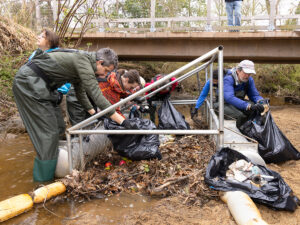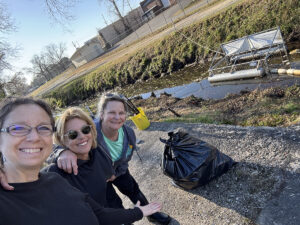


From individual trash traps to a much larger concept — Litter-Free Rivers.
Sound Rivers officially launched its Litter-Free Rivers program in 2023, a year after installing the first trash trap on Jack’s Creek in Washington.
“Litter-Free Rivers was named for one simple reason: to relay the goal we have for the Neuse and Tar-Pamlico rivers when it comes to trash and plastic pollution,” said Sound Rivers Executive Director Heather Deck. “Research has evolved so much in recent years, and we are now getting a pretty good glimpse into the harmful impacts trash has on our waterways — not only from a public health standpoint, but also a water-recreation safety standpoint. Our rivers should be fishable, swimmable and drinkable, and we can’t achieve that without addressing our litter pollution problem.”
In less than two years, Sound Rivers has grown the Litter-Free Rivers fleet to 10 trash traps on urban waterways across the Neuse and Tar-Pamlico watersheds. Each year, Sound Rivers staff, with the help of hundreds of volunteers, remove tons of trash from these traps — and your waterways.
About Trash Traps
Trash traps are passive litter-collection devices that are anchored to the banks of small, urban waterways. The buoy-lined anchor wires direct trash floating downstream into the mouth of the trap, where it remains until staff and/or volunteers pull it out to dispose of it in its proper place: a landfill.
Locations for trash traps are carefully scouted because not all waterways are good fits. The depth of water, how fast the water flows, accessibility to the site and how much trash is funneled into that waterway are just a few considerations when picking the ideal location for a trash trap.
Trash Trap Locations
Litter-Free Rivers was spurred by a statewide study on microplastics: where they come from, how they get in our waterways, how long it takes them to break down, and more. Since its launch, the litter traps have caught on. Sound Rivers has continued to grow Litter-Free Rivers in partnership with the cities of Washington, New Bern, Raleigh, Kinston, Greenville and Tarboro. Sound Rivers’ participation in microplastic research continues with one of three trash traps now located on Marsh Creek in Raleigh, operated in partnership with N.C. State University researchers.
Other Litter-Free Rivers trash traps are located on Jack’s Creek and an unnamed tributary of Jack’s Creek in Washington, Duffyfield Canal in New Bern, Little Rock Creek and Marsh Creek in Raleigh, Adkin Branch in Kinston, Greens Mill Run in Greenville and East Tarboro Canal in Tarboro.
An 11th trash trap is on its way, with the recent approval of a trash trap for Little Creek by the Clayton City Council.


Litter-Free Volunteering
Trash trap cleanouts are hosted monthly across the Neuse and Tar-Pamlico watersheds, and we’re always looking for a few good volunteers to don some waders and climb in the creeks to retrieve trash the traps have collected!
Sometimes there’s not a whole lot of trash; other times, especially after a big rain, a single trap can net up to 150 pounds of garbage. While the most common finds are plastic bottles and Styrofoam pieces, there’s always something rather uncommon that makes its way into the trap: shoes, Christmas ornaments, toys, athletic gear and more — if it can be carried by stormwater, it can end up in the water!
Adopt A Trash Trap
Sound Rivers also launched the Adopt A Trash Trap program in 2024, giving groups the opportunity to participate in keeping their waterways litter-free by signing up for a month of monitoring a trap, organizing clean-outs and reporting how much trash is removed. Groups aren’t defined in any way: it could be a student group, a civic group or even a group of friends.
Sound Rivers supplies everything you need to do the job, provides up to five T-shirts for your group and shares your good work via social media.

Litter-Free Partners
Litter-Free Rivers provides an opportunity to see just how much trash ends up in even small waterways, and for those concerned about it to do something by volunteering to monitor and/or clean out the traps.
“The program has been extremely successful to date. We hope to expand to other urban areas over the next five years by finding key partnerships, which will allow us to build connections with local communities, both with community-led groups and municipal partnerships,” Heather said.
Some of those partnerships include The Great Raleigh Cleanup, the Walnut Creek Wetland Community Partnership, Mother Earth Brewing and Lincoln City Rising.
“Sound Rivers can’t do this work alone, and building bridges into communities with partnerships results in an ever-expanding network of clean-water advocates, or activists,” Heather said.
Grady-White Boats and the Winston Family Foundation are sponsors of Sound Rivers’ Litter-Free Rivers program.
If you’re interested in sponsoring or supporting Litter-Free Rivers, we’d love to have your help! Email Development Coordinator Jay Potter at jay@soundrivers.org.

Girl Scouts take on Jack’s Creek
May 8th 2025

Litter-Free Rivers expands to Little Creek, Clayton
May 1st 2025

Trash-trapping team, Washington
May 1st 2025

Riverkeeper: Kids' camp, Sound Rivers outing ‘meaningful’
April 24th 2025

Trash trap cleanout a scouting adventure
April 10th 2025

Saturday success: New Bern trash trap cleanout
April 3rd 2025

Raleigh trash traps get official ribbon-cutting
March 27th 2025

Litter-Free: big week for trash trap cleanouts
March 20th 2025

